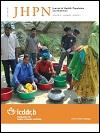Bioelectrical Impedance among Rural Bangladeshi Women during Pregnancy and in the Postpartum Period
DOI:
https://doi.org/10.3329/jhpn.v29i3.7871Keywords:
Bioelectrical impedance, Body composition, Phase angle, Pregnancy, Resistance, BangladeshAbstract
Properties of bioelectrical impedance analysis (BIA) reflect body-composition and may serve as stand-alone indicators of maternal health. Despite these potential roles, BIA properties during pregnancy and lactation in rural South Asian women have not been described previously, although pregnancy and infant health outcomes are often compromised. This paper reports the BIA properties among a large sample of pregnant and postpartum women of rural Bangladesh, aged 12-46 years, participating in a substudy of a communitybased, placebo-controlled trial of vitamin A or beta-carotene supplementation. Anthropometry and single frequency (50 kHz) BIA were assessed in 1,435 women during the first trimester (≤12 weeks gestation), in 1,237 women during the third trimester (32-36 weeks gestation), and in 1,141 women at 12-18 weeks postpartum. Resistance and reactance were recorded, and impedance and phase angle were calculated. Data were examined cross-sectionally to maximize sample-size at each timepoint, and the factors relating to BIA properties were explored. Women were typically young, primiparous and lacking formal education (22.2±6.3 years old, 42.2% primiparous, and 39.7% unschooled among the first trimester participants). Weight (kg), resistance (Ω), and reactance (Ω) were 42.1±5.7, 688±77, and 73±12 in the first trimester; 47.7±5.9, 646±77, and 64±12 in the third trimester; and 42.7±5.6, 699±79, and 72±12 postpartum respectively. Resistance declined with age and increased with body mass index. Resistance was higher than that observed in other, non-Asian pregnant populations, likely reflecting considerably smaller body-volume among Bangladeshi women. Resistance and reactance decreased in advanced stage of pregnancy as the rate of gain in weight increased, returning to the first trimester values by the three months postpartum. Normative distributions of BIA properties are presented for rural Bangladeshi women across a reproductive cycle that may be related to pregnancy outcomes and ultimately be used for assessing body-composition in this population.
Key words: Bioelectrical impedance; Body composition; Phase angle; Pregnancy; Resistance; Bangladesh
DOI: http://dx.doi.org/10.3329/jhpn.v29i3.7871
J HEALTH POPUL NUTR 2011 Jun;29(3):236-244
Downloads
285
304

